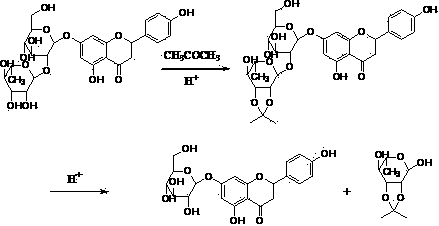Method for preparing mono-glucoside through selective hydrolysis of flavone rutinoside or neohesperidoside
A new technology of hesperidoside and rutinoside, which is applied in the fields of chemistry and medicine, and can solve problems such as inability to disperse and difficulty in dissolving
- Summary
- Abstract
- Description
- Claims
- Application Information
AI Technical Summary
Problems solved by technology
Method used
Image
Examples
preparation example Construction
[0051] The invention discloses flavone rutinoside compounds or flavone neohesperidoside compounds, which are adsorbed, dispersed and solidified by a macroporous adsorption resin, and rhamnose and ketones in the molecule are condensed to form flavone rutinoside ketal compounds or flavones Neohesperidoside ketal compounds, a general preparation method for preparing flavonoid glucoside compounds by hydrolyzing rhamnose. Those skilled in the art can refer to the content of this article to appropriately improve the process parameters of different flavonoid rutinosides or neohesperidoside compounds, such as adjusting the type and amount of resin; the type and amount of ketone; the type and amount of acid; temperature, etc. To realize the hydrolysis of different flavone rutinosides or neohesperidose compounds to prepare flavone monoglucoside. In particular, it should be pointed out that in the process of hydrolyzing various flavone rutinosides or neohesperidosides to prepare flavone ...
Embodiment 1
[0054] Example 1: Preparation of diomin-7-O-glucoside by diomin
[0055] Weigh 10g of 90% diomin, add 3.0g of KOH, add 150ml of water, shake well until the hesperidin dissolves (red-brown solution), add 140g (246ml) of macroporous adsorption resin, shake well, and slowly Slowly add acetic acid dropwise until acidic (red-brown color gradually fades), then add 2ml of acetic acid, shake well, add 10g of macroporous adsorption resin, shake well, let stand for 30min, filter, wash with 300ml of water several times until filtered, pump To dry, wrap the macroporous adsorption resin with paper and dry at 60°C. Put the macroporous adsorption resin in a 500ml flask, add 150ml of acetone (AR), soak for 1 hour, shake until no bubbles emerge from the resin, quickly add 3.g of anhydrous calcium chloride, add 1ml of concentrated sulfuric acid, shake well, ℃ air bath, airtight hydrolysis, TLC tracking (every 4h) inspection, until there is no obvious spot on TLC of diomin and its ketal compoun...
Embodiment 2
[0057] Example 2: Preparation of apigenin-7-O-glucoside from Rhododendron
[0058] Weigh 10g of 98% Rhodoglucoside, add 3.0g of KOH, add 140ml of water, shake well until the Rhodoglucoside is dissolved (brownish yellow solution), add 140g (245ml) of macroporous adsorption resin, shake well, shake while slowly Slowly add acetic acid dropwise to acidity (the color of rhotropin fades gradually), then add 2ml of acetic acid, shake well, add 10g of macroporous adsorption resin, shake well, let stand for 30min, filter, wash with 300ml of water several times, filter, pump To dry, wrap the macroporous adsorption resin with paper and dry at 60°C. Put the macroporous adsorption resin in a 500ml flask, add 150ml of acetone (AR), infiltrate for 1 hour, shake until no bubbles emerge from the resin, quickly add 3.g of anhydrous calcium chloride, add 1ml of methanesulfonic acid, shake well, and In an air bath at 50°C, airtight hydrolysis, TLC tracking (every 4h) inspection, until there are ...
PUM
 Login to View More
Login to View More Abstract
Description
Claims
Application Information
 Login to View More
Login to View More - R&D
- Intellectual Property
- Life Sciences
- Materials
- Tech Scout
- Unparalleled Data Quality
- Higher Quality Content
- 60% Fewer Hallucinations
Browse by: Latest US Patents, China's latest patents, Technical Efficacy Thesaurus, Application Domain, Technology Topic, Popular Technical Reports.
© 2025 PatSnap. All rights reserved.Legal|Privacy policy|Modern Slavery Act Transparency Statement|Sitemap|About US| Contact US: help@patsnap.com



